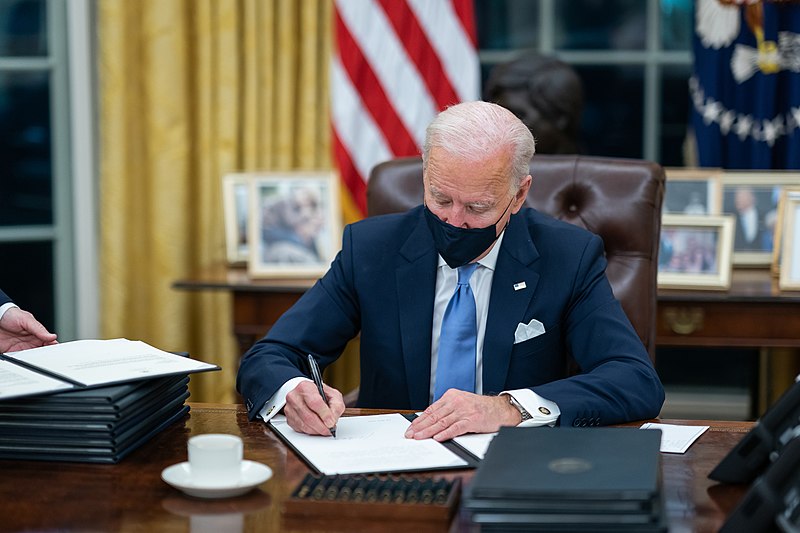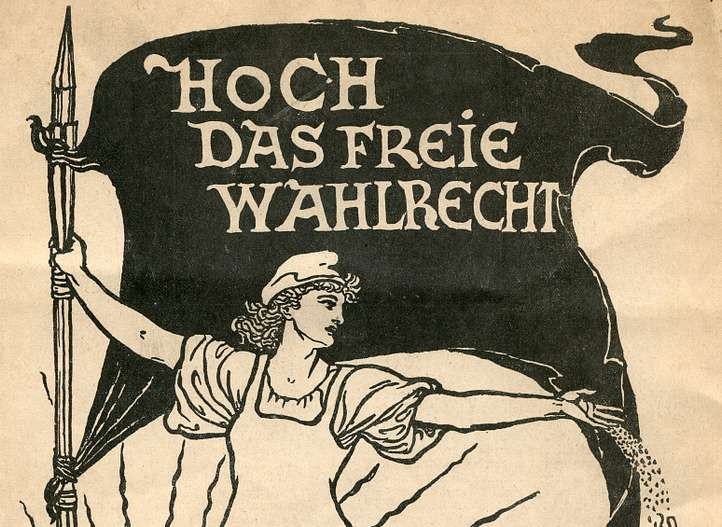US President Joe Biden marks his one-year anniversary in office on January 20th. He landed in the White House on the back of lofty comparisons to Franklin Delano Roosevelt, as Democrats eked out a win in a year they thought they’d take in a landslide. And Biden has been lowering the public’s expectations ever since.
The FDR analogy was preposterous from the jump. No doubt this messaging from elite Democrats aimed to evoke a time when the federal government intervened in a crisis – in this case the Great Depression – to pass sweeping social policy and make regular people’s lives more liveable. (Meanwhile, their behind-the-scenes machinations had just torpedoed Bernie Sanders, the one Democratic candidate who actually planned to enact such an ambitious agenda.) Certainly, today’s conditions have parallels to the Great Depression, although we face a particular set of interlocking crises now, from rampant inequality to ecological catastrophe to the global pandemic.
But for the FDR comparisons to stand, Biden would have pass through Congress social programs on par with the New Deal, which created the US’s welfare state and first set of labor protections. Despite its severe limitations, the New Deal is arguably the most significant set of pro-working-class reforms in the country’s history.
But Congress isn’t in the business of passing ambitious social programs these days. We knew going into Biden’s presidency that this longtime champion of bipartisanship was unlikely to buck the donor class now, and do something for workers and the poor. Unsurprisingly, even Biden’s campaign promise for a watered-down alternative to universal healthcare, the public option, seemed to disappear after he took office.
That said, even dreaming smaller, Biden and his party had the last twelve months to pass something to raise the standard of living for American workers, and to merit the faintest of comparisons with FDR: a higher minimum wage; meaningful relief for workers and the unemployed hit by the pandemic in myriad ways; improved conditions for labor organizing.
Of course, it would be misguided to think we can separate what we might call “economic issues” from equally pressuring crises like climate change, immigration, and the right-wing assault on democracy – all issues that affect workers and working-class power, and all fronts on which the Biden administration appears to have thrown up its hands. But in the spirit of the New Deal comparison, it’s worth asking a narrower question: how have Biden and the Democrats affected workers and the social safety net? A year in, let’s take a clear-eyed organizer’s look at what they’ve done, what they haven’t, and what we might still win.
The American Rescue Plan: better than nothing
Biden signed into law a $1.9 trillion dollar pandemic relief package in March 2021. It amounted to a much-needed injection of emergency funding without shifting the balance of power.
The good: The bill included direct cash aid to workers, families, and the unemployed. State and local governments together got $350 billion. Individuals got one-time stimulus payments of $1,400 ($2,800 for married couples), and parents got $1,400 per child, within income limits. The bill temporarily extended the $300-a-week unemployment bonus to those out of work, and people on unemployment saw a raise in the number of weeks they could collect benefits, from 50 to 74. And it extended the existing 15% increase in SNAP benefits (i.e. food stamps).
The package also raised the child tax credit from a monthly $167 to $300 per child under six and $250 for children aged six to seventeen. Democrats were quick to trumpet that they’d “cut child poverty in half,” but that claim depended on making the boosted child tax credit permanent, a task it appears they’ve now failed.
It’s worth mentioning the federal eviction moratorium, not actually part of this bill, which Biden and Congress passed and extended at various points to give temporary and desperately-needed relief to renters, only to be overturned by the Supreme Court in August 2021.
The bad: There were two glaring omissions from the American Rescue Plan that ensured it didn’t challenge the status quo. The first is its utter failure to take the steps needed to end the pandemic. Yes, it provided a massive influx of funding for vaccination, testing, and the Federal Emergency Management Administration (FEMA). However, the only way to get the pandemic truly under control is to vaccinate the global population, a goal at odds with pharmaceutical company profits. In allowing Pfizer and Moderna to keep their vaccine patents secret, Biden and Democrats cut off the possibility of making vaccines widely available in poorer countries.
Since the bill’s passage, the coronavirus has continued to circulate and mutate into new variants, leaving people in the US (and the world) to a 2022 that looks awfully like 2020 and 2021, or worse. And the Biden administration and the CDC have continued to bungle the pandemic response, from massive testing shortages to guidance that infected people can return to work in a mere five days.
Secondly, the pandemic relief bill is where Biden showed he never intended to make good on his campaign promise of a $15 minimum wage. After a ruling from the unelected Senate parliamentarian that a minimum wage increase couldn’t pass through reconciliation – which they could have ignored – Democrats declared $15 an hour dead.
And, since this is Biden and the Democrats, the bill wouldn’t be complete without a corporate handout. Its solution to people losing their health insurance in droves as they lost their jobs was to funnel tens of billions of dollars to health insurance companies. The legislation created subsidies for people to get on expensive Affordable Care Act (ACA) plans and COBRA plans (which allow people to keep their employer-sponsored health insurance after they lose their jobs). With more people on these pricy plans, the health insurance industry stands to profit handsomely, leaving ACA recipients saddled with ten times the out-of-pocket costs of Medicaid recipients.
So what?: These pandemic benefits had a real impact on working people’s lives. However, since they were one-time or temporary, they qualify in this analysis as “the good” only in the limited sense that they exceeded rock-bottom expectations of the federal government, imposed by years of austerity starting with Clinton. Far from constituting any restructuring of the economy or the rules that govern it, the temporary redistribution of income to the bottom of the scale did nothing to alter the balance of power between capital and labor.
We shouldn’t confuse Biden’s emergency relief for the launch of a new era of meaningful social spending in government. Many of the benefits Democrats passed were continuations from the Trump administration’s emergency measures. The stimulus payments and child tax credits were, of course, means-tested rather than universal. And the Biden campaign’s original promise was a $2,000 check, making one of Biden and Harris’ first acts in office an attempt to lower the public’s expectations and pretend they’d meant $1,400 all along.
Build Back What?
Biden’s other main attempt at signature legislation this year was just as notable for the political maneuvering that went into it as it was for its content. He had campaigned on a broad “Build Back Better agenda” that included both revitalizing the nation’s infrastructure and a set of social programs. Congressional leaders landed on a strategy of splitting the two projects into separate bills, knowing that the former – dubbed the Infrastructure Investment and Jobs Act – would have a much better chance of passing through the Senate than the latter.
The Senate is currently split 50-50, with Vice President Harris casting the tie-breaking vote. Most legislation must pass the Senate with 60 votes, but under a process called reconciliation, certain kinds of bills can pass with a simple majority. But the makeup of the Senate means that Democrats can’t afford a single no vote to pass a bill via reconciliation, and conservative Democrats Joe Manchin and Kyrsten Sinema often prove obstacles to this perfect 50 votes. (Whether they are truly the only thing standing between Democrats and their purported agenda, or whether they give cover to a host of other corporate-captured senators, depends on whom you ask.)
As the two-bill strategy solidified, despite pushback from progressives, the social programs were lumped into a reconciliation bill, eventually named the Build Back Better Act (BBB). Democratic leaders in Congress dealt the first fatal blow to their own public-facing agenda by scheduling a vote on the infrastructure bill before Build Back Better, despite resistance from the Squad and progressives, who knew this move would lose them any leverage to withhold votes. But the credulous Progressive Caucus leadership accepted a promise in writing that Congress would vote soon on BBB. The infrastructure bill passed in November at $1.2 trillion. In negotiations with Biden and Democrats, Manchin succeeded in whittling down BBB from $3.5 trillion to $1.7 trillion – and then, on December 19, Manchin appeared on Fox News and announced he would vote no on the bill. Barring a miracle, BBB is dead.
The good: Was there anything to celebrate in the infrastructure bill? It directed $550 billion to roads, passenger and freight rail, broadband access, updating the electric grid, water and wastewater systems (e.g. replacing lead pipes), and public transit. But this “good,” like the emergency pandemic aid, is an influx of cash without any real redistribution of power or changes to the structure of the economy. And, unlike the pandemic relief package that was better than nothing, some have argued the infrastructure bill was worse than nothing. Let’s take a look at why.
The bad: The first notable thing here is what the infrastructure bill did do. Biden, ever-bipartisan, spent precious time and political capital trying to get Republicans to vote for the infrastructure bill. Since Republicans balked at new taxes, the funding for the bill comes from a hodgepodge of sources, notably cannibalizing unused pandemic unemployment funding (while more than half of US states refused this extended funding, leaving the unemployed in a lurch). Other funding sources usher in privatization via public-private partnerships and “asset recycling,” in which the government sells off old infrastructure to private companies to pay for new infrastructure. Wall Street, understandably, is thrilled.
But the second notable thing is the content of what we lost. In giving up on Build Back Better, Biden and the Democrats doomed a laundry list of social programs that had made it into the bill:
- an expansion of the child tax credit
- paid family and medical leave (originally twelve weeks and cut down to four in the whittled-down version that Manchin rejected)
- free preschool for three- and four-year-olds and lowered childcare costs
- two years of free community college (also eliminated in the final version)
- piecemeal but significant healthcare reforms like a cap on insulin expenses, expanding Medicaid to vision, hearing and dental, and allowing Medicare to negotiate drug prices with manufacturers
- A Civilian Climate Corps – a far cry from a Green New Deal, but a direct callback to FDR’s Civilian Conservation Corps, which would offer government jobs for environmental protection and conservation
- Large-scale investment in producing and maintaining affordable housing
Any one of these things would have provided a material change in the daily lives of working people, taking them from the edge of precarity and freeing up their capacity to fight for themselves. The death of BBB dealt a devastating blow to any hopes of shifting the balance of power under Biden.
So what?: Biden and the Democrats’ were either unable, or refused, to pass these social programs, while they handed over our infrastructure to private corporations. Without massive pressure from below of the kind that led to the New Deal, the political calculus for them pointed squarely at governing in service of capital and the donor class. This doesn’t tell us much about them that we don’t already know, except perhaps to put the nail in the coffin of any hopes that Biden would usher in a new era of social democracy or achieve something remotely on par with FDR.
Maybe the real interesting story for organizing here is Congressional progressives’ strategy, tactics, and ultimate failure in wielding real leverage by withholding votes. This wasn’t their only action this year that broke from the non-confrontational status quo; members of the Squad camped out overnight on the Capitol steps in July to agitate for extending the eviction moratorium. Additional ink has been spilled over the need for progressives to use their leverage, and this fight’s implications for how we pressure legislators from below.
For now, it’s worth noting that members of the Squad are willing to withhold votes, and, if we can mobilize in large numbers, there might be opportunities in the next year to pressure or support them into acting even more confrontationally. (The revived Left has yet to succeed in such an undertaking even toward friendly representatives.) But the Squad stands at six members, and we shouldn’t assume that all Congressional “progressives” (a slippery term) share their politics and pressure points. We can’t count on Progressive Caucus leader Pramila Jayapal nor its other rank-and-file members – nor mainstream Democrats, it should be said – to use their power for working people after they caved on BBB, at least not without massive public pressure of the type the Left hasn’t pulled off in recent decades.
After BBB’s very public death knell, Democrats shifted quickly to voting rights, trying to pass two bills through Congress that would level the electoral playing field after increasingly blatant antidemocratic moves by Republicans. But as of today, they’ve openly given up on that, too.
What about unions?
The start of the Biden administration gave labor grounds for cautious optimism. In January, Biden fired Peter Robb, Trump’s anti-union head of the National Labor Relations Board, and in July the Senate confirmed the more pro-union Jennifer Abruzzo.
Early in Biden’s term, hopes were high that Congress would pass the PRO Act, which would make sweeping changes to the country’s hostile organizing conditions and could start to reverse the long decline of US labor since the 1970s. But after the bill passed the House in March, its key provisions got lumped into the reconciliation bill. With the Senate’s razor-thin margin and Build Back Better all but dead, it’s hard to deny that labor’s hopes might be dashed on this one.
Biden’s public rhetoric on unions has been mixed. He supported the union drive of Amazon workers in Bessemer, Alabama, and more recently of striking Kellogg’s workers. But as the omicron variant has soared, Biden’s White House has weighed in against the Chicago Teachers’ Union demanding better safety protocols for themselves and their students, lending muscle to Mayor Lori Lightfoot in trying to force schools to stay open.
What does this mean for organizing conditions?
This is not an attempt to prescribe Left strategy for 2022 – others have done this more thoroughly. But many of the arguments for leftists to vote for Biden in the first place claimed that a Biden administration would allow for more fruitful organizing conditions than Trump would. After one year, what’s the lay of the land?
It’s easy to think we’re about where we were a year ago. With no minimum wage, no PRO Act, no free preschool or higher education – and, moreover, a pandemic that continues to kill people, strain hospitals, and interrupt daily life – conditions for working people haven’t undergone a seismic shift since January 2021. If anything, we face the compounded effects of multiple years of the pandemic on organizing. Practically speaking, organizers in labor, the Left, and movement formations lose a lot if the virus still rages. Who will persevere through another year of Zoom meetings? Organizing by definition turns on in-person contact and relationships.
But where does a US left-leaning movement apply pressure to end the pandemic by vaccinating poorer countries? Who’s in this movement, and what institutions anchor it? The former question at least has an answer, even if it’s such a tall order as to seem out of reach: we’d have to force Congress to have pharmaceutical companies open up their vaccine patents. Any shift in the power relations between labor and capital requires a version of this same answer – mass organization.
But the latter question gives us answers we don’t like. The US Left, despite its resurgence since 2016, is nowhere near as large or as internally organized as it needs to be to exert the pressure to pull this off. There’s a huge gap between the challenges we face and what Left and labor institutions are equipped to do. Even if Biden’s first year had been a best-case scenario, it wouldn’t have solved the fundamental problem for the US Left – merging with the broad, multi-racial working class, which must include revitalizing organized labor to be militant and democratic.
However, there’s a silver lining: since our long-term project of relinking the Left and labor into a fighting mass remains the same after a year of Biden has come and gone, we can continue to pursue it. And signs abound that organized labor is on the upswing, including enough high-profile strikes that mainstream outlets called 2021 “the year of the worker,” but also the lesser-known victories for union democracy at UAW and the Teamsters. A world with the PRO Act in place would have drastically eased the conditions for organizing new unions, but socialists still need to do the work of building relationships with organic labor leaders, and we can work towards that even if Biden furiously maintains the status quo.
A one-year retrospective on the sitting US president helps us reflect on our current organizing moment, but the premise can be misleading: we must be careful not to fall into a top-down theory of change where we wait for individuals like Biden, or institutions like Congress, to give out victories for working people. If we’re going to win any moves toward a redistributive agenda, let alone the foundations of a fundamental shift in the economic order, the pressure has to come from below.




